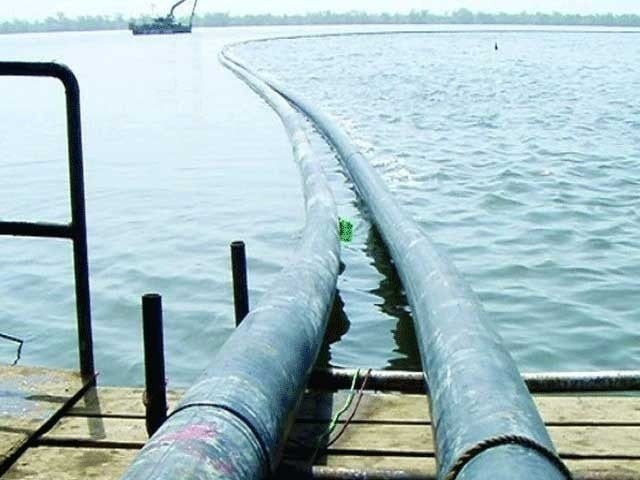Sindh, Centre water row persists
CM rejects IRSA’s three-tier formula, urges federal minister to uphold 1991 Accord

Sindh Chief Minister Murad Ali Shah categorically told Federal Minister for Water Resources Moonis Elahi that the provincial government would not accept any water sharing formula other than the Water Apportionment Accord agreed to in 1991. He clarified that this includes the controversial three-tier rule enforced by the Indus River System Authority (IRSA) for the Rabi season from October 1, 2021 to March 31, 2022.
Shah instead suggested that measures should be taken to strengthen IRSA so that it could implement the 1991 Accord. The meeting was held here on Monday at the Chief Minister’s House. Ellahi was assisted by Federal Water Secretary Shahzad Bangash, Joint Secretary Water Mehar Ali Shah and Director Ashar Abbas Zaidi. The CM was assisted by his team, including Irrigation Minister Jam Khan Shoro, Planning and Department Chairperson Hassan Naqvi, Irrigation Chief Engineer Zareef Khero, IRSA member Zahid Junejo and CM’s Additional Secretary Fayaz Jatoi.
From the outset of the meeting, federal minister Moonis Illahi said that he had started meeting stakeholders in the province to hear their point of view on the water sharing scheme. He added that he wanted to resolve all the outstanding issues amicably.
The CM, welcoming the federal minister and his efforts to resolve the water sharing issue, said that the 1991 Accord was approved by the Council of Common Interest and acceptable to all the provinces.
“Our grievance is very simple, we want the federal government to strengthen IRSA to enable the body to implement the water accord in its true letter and spirit,” he said.
The CM added that IRSA failed to implement the accord and allowed Punjab to open its link canals. Speaking about the role of IRSA, Shah said that the authority was unable to implement sharing in times of shortage, as indicated by seasonal allocations of different canal systems ratified by CCI on September 16, 1991.
He emphasised that the shortages should be shared by the provinces.
Three-tier formula
The chief minister, discussing the impact of the three-tier formula during kharif, said that Punjab, K-P and Balochistan would get more water, if distribution was made as per the three tiers.
Shah, elaborating his point, said that 73.68 MAF water was available under the formula. He added that during the kharif season, Punjab would get 38.21 MAF of water, Sindh 31.80 MAF, Balochistan 2.85 MAF and K-P 0.82 MAF.
Read More: Water theft network busted
He added that under the 1991 Accord, Punjab would get 36.57 MAF of water, Sindh 33.49 MAf, Balochistan 2.81 and K-P 0.80 MAF.
“The difference between the three tier formula vis a vis 1991 Accord shows that Punjab would get 1.64 MAF, Balochistan 0.04 MAF and KPK 0.02 MAF more water and Sindh would get 1.69 MAF less water.” He clarified that his government would never accept a three-tier formula because history showed that every successive formula has been curtailing the water share of the people of Sindh.
Federal Minister for Water Moonis Ellahi said that he was not in favour of reducing Sindh’s water share and that we would discuss the matter with other provinces so that just distribution of water could be ensured.
Shah, taking a glance into the pages of history, said that Indus water has been put to irrigation use since the last several centuries.
Initially, there were inundation canals and withdrawals from them were dependent on the level of water in the river. The CM continued that the first headwork was constructed on the Ravi River in Punjab during the 19th Century. “After that, several other headworks were constructed across the tributary’s rivers from 1882-1901 and the first Barrage across Indus - Sukkur Barrage - was constructed in 1932.
Shah said that after construction of the Sutlej Valley Canals Project in 1933, certain difficulties arose for sharing of water amongst the states of Bikaner, Bahawalpur, Khairpur and Punjab.
“In order to resolve the issue, the government of India appointed the Anderson committee in 1937,” he said.”The Anderson Committee submitted its recommendations regarding water allocation of the then existing canal system and proposed a Thal Canal.”
He further stated that the government approved the recommendation of the Anderson Committee.
Shah said that in 1940, on the complaint of Sindh against the proposed Bhakra dam project of Punjab, the government of [India] appointed the Rau Commission for investigation. In light of the recommendations of the Rau Commission, the negotiations between Punjab and Sindh were initiated in 1943 and during September 1945, an agreement was signed by the chief engineers of Punjab and Sindh.
This is known as the Sindh-Punjab Agreement, the CM said.
Published in The Express Tribune, October 12th, 2021.



















COMMENTS
Comments are moderated and generally will be posted if they are on-topic and not abusive.
For more information, please see our Comments FAQ